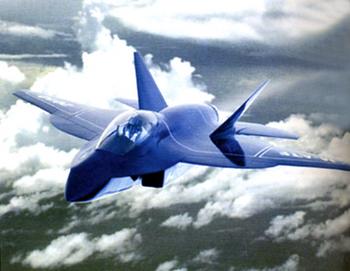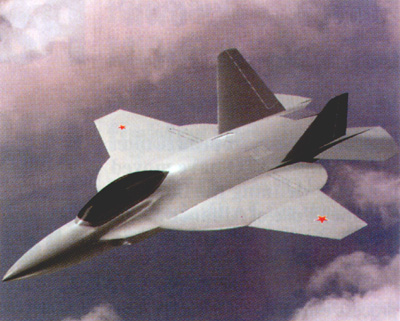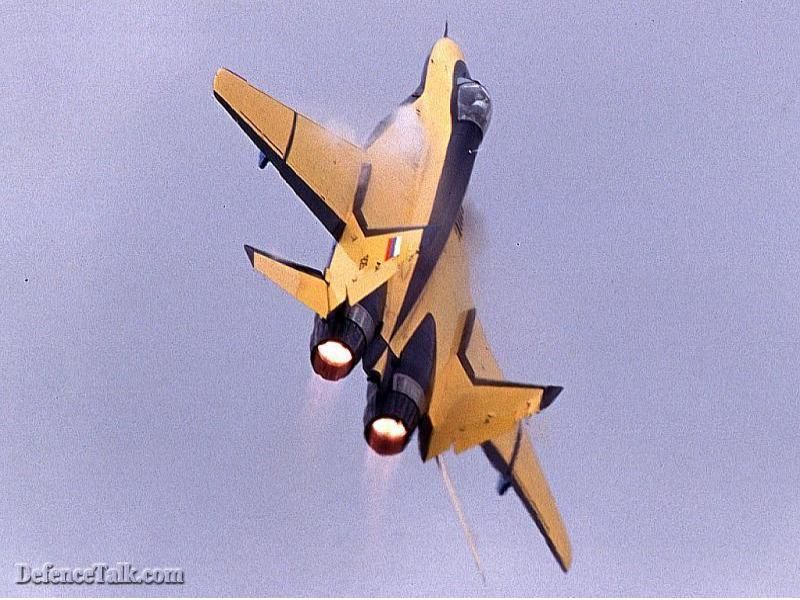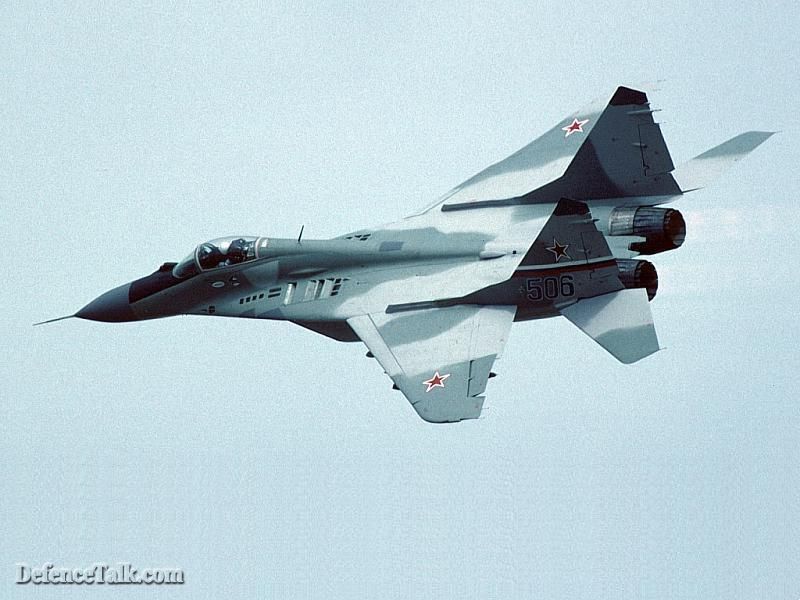PAK-FA Sukhoi T-50 not KAI
ca | 2005-07-27 18:37:55
조회 6219 | 추천 0 | 다운로드 7
PAK-FA Sukhoi T-50
http://warfare.ru/?catid=255&linkid=2280 원문 출처
http://pakistanidefenceforum.com/lofiversion/index.php/f6.html 파키스탄 비밀?
http://pakistanidefenceforum.com/lofiversion/index.php/t46876.html 파키스탄 비밀 측의 노르웨이군들 , 종합 ground
///////////////////////////////////////본문시작//////////////////////////////////////
PAK-FA Sukhoi T-50
Discuss Email
Video Additional
Engines: AL-41F1 2*15500 kgs.
Weight:
VSTOL 21000 kg
max 32800 kg (runway 160m)/31600 kg
Fuel (int) 7000 /10800 kg
Dimensions 20.6 x 14.4 / 7.82 x 5.84 м
Sq 54.6 /77 sq.m
Max speed 2250 km/h
Alt.: 18800 m
Load balance: 0.95
Flight range: 4200-5500/7400 km
Armament: 2x30mm gun
Hardpoints: 8 (conf.), 2*4
Development of Russia's LFI (logkiy frontovoi istrebitel) lightweight tactical fighter has been dramatically accelerated after the Russian Air Force decided its priorities for the next 10 years. Revealed here exclusively as the I-2000 (Istrebitel {fighter} 2000) project, the aircraft is due to become operational in 2005 as Russia's
The aircraft comes from a long line of Mikoyan lightweight fighters, such as the MiG-15 and MiG-21. It is about the same size as the MiG-21 (shorter by 1.3m but wider by 4.5m), but noticeably smaller than its immediate predecessor, the MiG-29. Take-off weight is estimated at around 12 tonnes; maximum take-off weight at about 16 tonnes.
[1]
In early 2002 Sukhoi was chosen as prime contractor for the planned Russian fifth-generation fighter is called the PAK FA [ Perspektivnyi Aviatsionnyi Kompleks Frontovoi Aviatsyi - Future Air Complex for Tactical Air Forces]. This intermediate class twin-engined fighter will be larger than a MiG-29 and smaller than a Su-27.
The aircraft will feature a long combat radius, supersonic cruise speed, low radar cross section, supermaneuverability?, and the ability to make short takeoffs and landings. In accordance with the technical requirements, the PAK FA will have a normal takeoff weight of 20 tons, which is close to the average normal takeoff weight of the two American airplanes, the F-35 JSF (17.2 tons) and the F-22 (24 tons). The new fighter (a medium version) will have a traditional wing form, though the experience gathered as a result of Berkut's test flights will be taken in consideration when designing the fighter. It is supposed that it will be created using the Stealth technology, and equipped with two AL-41F engines by the Saturn scientific and industrial enterprise, a radar system with an active phased array (to all appearances, it will be produced by the Fazatron-NIIR corporation), and high-precision weapons.
The government commission decided on 26 April 2002 to choose the Sukhoi holding company as the head company to develop and produce the fighter of the fifth generation. The prototype of the PAK FA would take-off in 2006 and that in 2010 the aircraft would be ready for series production. The first deliveries, both for Russian armed forces and for export, would be possible in 2011-12 .
The new airplane is being proposed to be brought from the concept design to a prototype series in less than 9 years. Historically, fourth and fifth generation fighters have not been created in less than 15 years. The Russian government has promised to allocate 1.5 billion dollars for the PAK FA through 2010. But the Russian Air Force is receiving less than 200 million dollars a year during this period, and will spend it primarily on other needs.
The prices and sources of funding will determine the destiny of the whole program. To date officials agree that the program will cost $1.5 billion. However, $1.5 billion is the sum needed for creating a new generation of avionics for the fighter (considering the fact that pre-production models of the phased array have already been produced, and will soon be tested). Completion of the AL-41F engine (present readiness is 30 percent) will require, in the opinion of the boss of Rosaviakosmos, 600 - 800 million dollars. Saturn said that launching of production of the AL-41F engine would take $150 million. An improved version of the AL-31F will be used on the aircraft originally (though it is not clear how these heavy motors are reconciled with the concept of a 20-ton fighter). The upgrade of these engines will require expenditures of 1.2-1.5 billion dollars. And finally, designers will have to spend several hundred millions of dollars on creating a new airframe.
According to some reports, India and Russia have agreed to jointly develop this fifth-generation fighter , under a scheduled with entery into service in 2009 . This would be the first such joint development venture between the two countries.
[8]
Copyright © 1997- 2005 Eugene Yanko in association with Omsk VTTV Arms Exhibition and Military Parade JSC. All Rights Reserved. Website contains materials of Sukhoi, MAPO MIG, Rosoboronexport, Boeing, Jane's and other copyright owners. Credits & Sources. Reproduction without permission is prohibited.::.
http://warfare.ru/?catid=255&linkid=2280 원문 출처
http://pakistanidefenceforum.com/lofiversion/index.php/f6.html 파키스탄 비밀?
http://pakistanidefenceforum.com/lofiversion/index.php/t46876.html 파키스탄 비밀 측의 노르웨이군들 , 종합 ground
///////////////////////////////////////본문시작//////////////////////////////////////
PAK-FA Sukhoi T-50
Discuss Email
Video Additional
Engines: AL-41F1 2*15500 kgs.
Weight:
VSTOL 21000 kg
max 32800 kg (runway 160m)/31600 kg
Fuel (int) 7000 /10800 kg
Dimensions 20.6 x 14.4 / 7.82 x 5.84 м
Sq 54.6 /77 sq.m
Max speed 2250 km/h
Alt.: 18800 m
Load balance: 0.95
Flight range: 4200-5500/7400 km
Armament: 2x30mm gun
Hardpoints: 8 (conf.), 2*4
Development of Russia's LFI (logkiy frontovoi istrebitel) lightweight tactical fighter has been dramatically accelerated after the Russian Air Force decided its priorities for the next 10 years. Revealed here exclusively as the I-2000 (Istrebitel {fighter} 2000) project, the aircraft is due to become operational in 2005 as Russia's
basic front-line fighter.
It is also likely to become the leading export product of the Russian aircraft industry. Available information on the I-2000 indicates that it will be closely comparable to the US Joint Strike Fighter , operating in both the air-to-air and air-to-surface roles.The aircraft comes from a long line of Mikoyan lightweight fighters, such as the MiG-15 and MiG-21. It is about the same size as the MiG-21 (shorter by 1.3m but wider by 4.5m), but noticeably smaller than its immediate predecessor, the MiG-29. Take-off weight is estimated at around 12 tonnes; maximum take-off weight at about 16 tonnes.
[1]
In early 2002 Sukhoi was chosen as prime contractor for the planned Russian fifth-generation fighter is called the PAK FA [ Perspektivnyi Aviatsionnyi Kompleks Frontovoi Aviatsyi - Future Air Complex for Tactical Air Forces]. This intermediate class twin-engined fighter will be larger than a MiG-29 and smaller than a Su-27.
The aircraft will feature a long combat radius, supersonic cruise speed, low radar cross section, supermaneuverability?, and the ability to make short takeoffs and landings. In accordance with the technical requirements, the PAK FA will have a normal takeoff weight of 20 tons, which is close to the average normal takeoff weight of the two American airplanes, the F-35 JSF (17.2 tons) and the F-22 (24 tons). The new fighter (a medium version) will have a traditional wing form, though the experience gathered as a result of Berkut's test flights will be taken in consideration when designing the fighter. It is supposed that it will be created using the Stealth technology, and equipped with two AL-41F engines by the Saturn scientific and industrial enterprise, a radar system with an active phased array (to all appearances, it will be produced by the Fazatron-NIIR corporation), and high-precision weapons.
The government commission decided on 26 April 2002 to choose the Sukhoi holding company as the head company to develop and produce the fighter of the fifth generation. The prototype of the PAK FA would take-off in 2006 and that in 2010 the aircraft would be ready for series production. The first deliveries, both for Russian armed forces and for export, would be possible in 2011-12 .
The new airplane is being proposed to be brought from the concept design to a prototype series in less than 9 years. Historically, fourth and fifth generation fighters have not been created in less than 15 years. The Russian government has promised to allocate 1.5 billion dollars for the PAK FA through 2010. But the Russian Air Force is receiving less than 200 million dollars a year during this period, and will spend it primarily on other needs.
The prices and sources of funding will determine the destiny of the whole program. To date officials agree that the program will cost $1.5 billion. However, $1.5 billion is the sum needed for creating a new generation of avionics for the fighter (considering the fact that pre-production models of the phased array have already been produced, and will soon be tested). Completion of the AL-41F engine (present readiness is 30 percent) will require, in the opinion of the boss of Rosaviakosmos, 600 - 800 million dollars. Saturn said that launching of production of the AL-41F engine would take $150 million. An improved version of the AL-31F will be used on the aircraft originally (though it is not clear how these heavy motors are reconciled with the concept of a 20-ton fighter). The upgrade of these engines will require expenditures of 1.2-1.5 billion dollars. And finally, designers will have to spend several hundred millions of dollars on creating a new airframe.
According to some reports, India and Russia have agreed to jointly develop this fifth-generation fighter , under a scheduled with entery into service in 2009 . This would be the first such joint development venture between the two countries.
[8]
Copyright © 1997- 2005 Eugene Yanko in association with Omsk VTTV Arms Exhibition and Military Parade JSC. All Rights Reserved. Website contains materials of Sukhoi, MAPO MIG, Rosoboronexport, Boeing, Jane's and other copyright owners. Credits & Sources. Reproduction without permission is prohibited.::.










 1
1


댓글 [5]
alfa156 | 2005-07-27 | 추천 0
스티븐 | 2005-07-27 | 추천 0
두더쥐 | 2005-07-27 | 추천 0
ca | 2005-07-27 | 추천 0
권영준 | 2005-07-27 | 추천 0